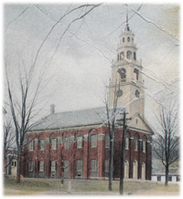The bricks & mortar
At the time of its construction, the South Church must have been Newport's largest masonry structure. Its financial patron, James Breck, no doubt insisted that it be made of brick (as he had done earlier for his own store), and each brick was hand-made from local clay. Local craftsmen set them by the tens of thousands in order to complete the church.
John Silver, mason
|
Edmund Wheeler's History of Newport lists several brick-makers, with the earliest dating back to 1776. The Nathan Mudget yard on Sunapee Street, the Wilcox yard on Spring Street, and the yard at the B. W. Jenks place at the corner of Oak and Pine Streets all employed several workers. Smaller makers included David Brown, Clark Emerson, Albert Hurd, and "a Mr. Bachelder made brick in the marsh above the school-house in District No. 14."
John Silver is credited as mason of the early brick buildings in Newport, including the Newport House (1814), the South Church (1823), the Eagle Hotel (1825), the Courthouse (1826). Working with him were John Silver Jr., Samuel Noyes, James Carr, Joseph Carr, George Tasker, and J.W. Sargent. Wheeler makes this rare reference to the actual construction of the South Church: |
|
Samuel Noyes, a brick-mason; son of Deacon Cutting Noyes; was fond of good-natured jokes. While building the Congregational church, which originally had a very large window at the rear of the pulpit, the pastor, Rev. Mr. Wheelock, remarked that it seemed very large; whereupon Mr. Noyes, looking on the assembled crowd, with a knowing wink, retorted—"Pretty much all the light we get from the pulpit we expect will come through that window." |
